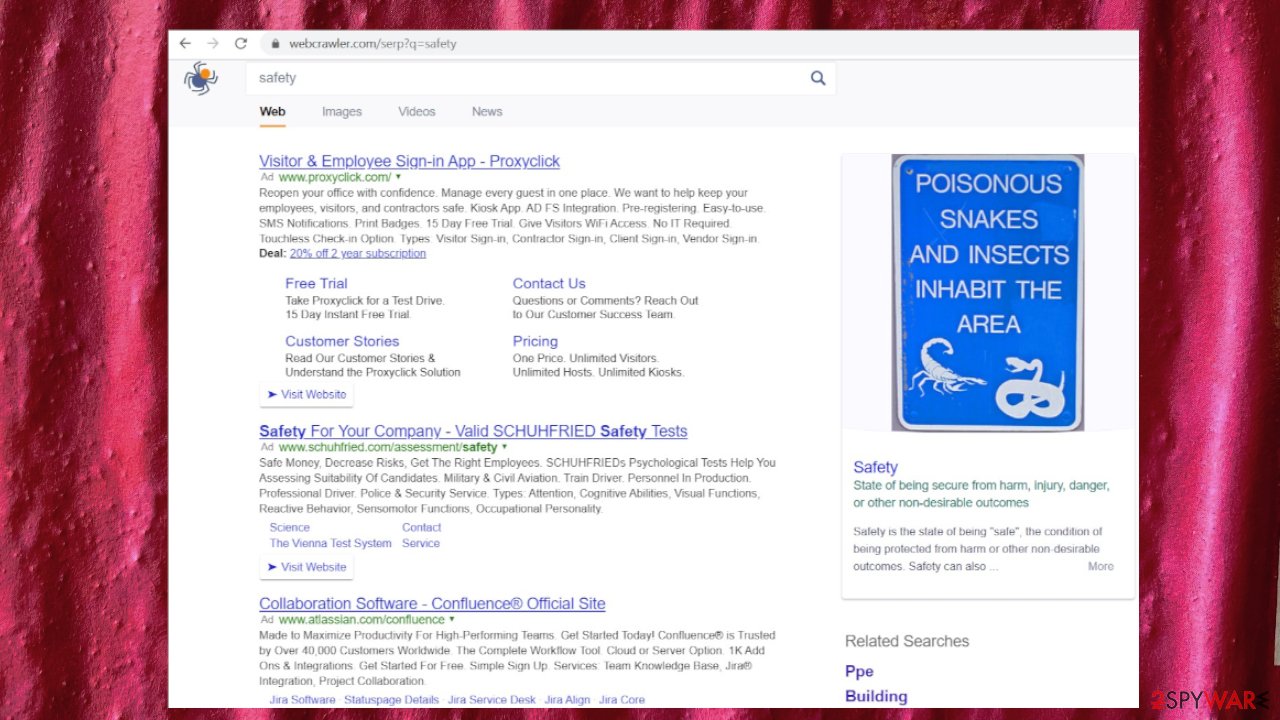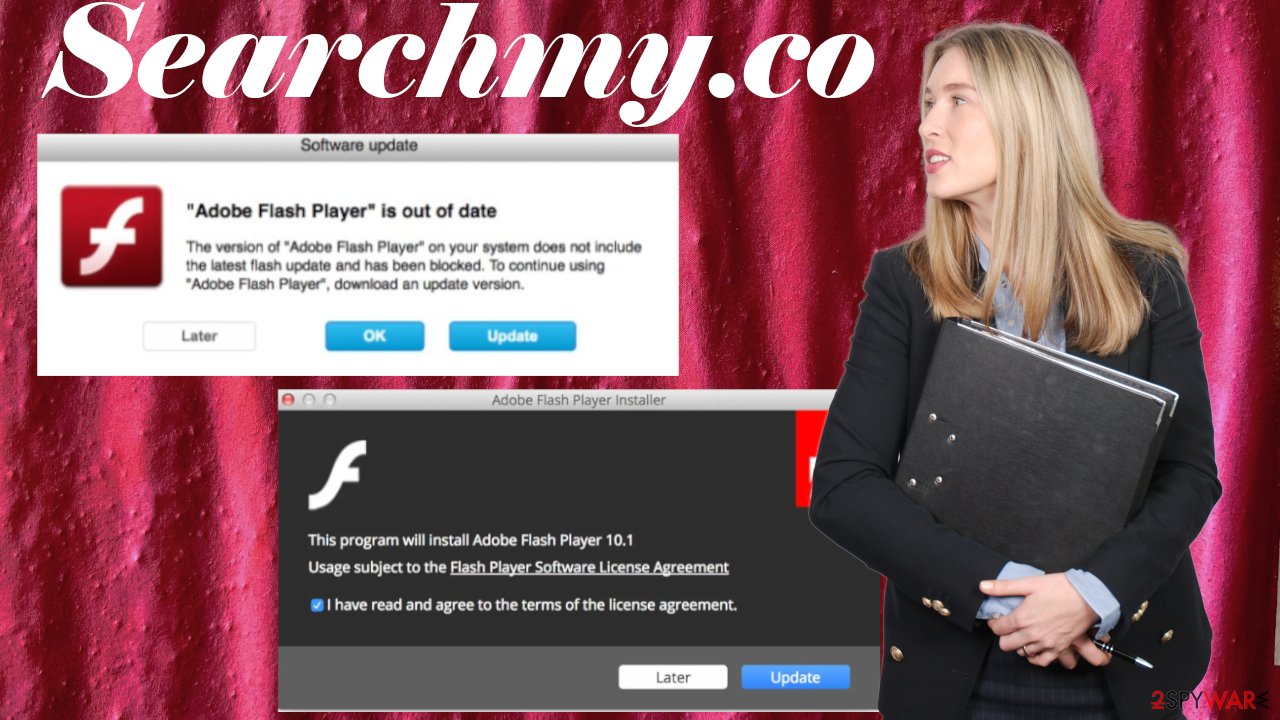Searchmy.co (Removal Guide) - Chrome, Firefox, IE, Edge
Searchmy.co Removal Guide
What is Searchmy.co?
Searchmy.co – a potentially unwanted program that's not that easy to get rid of

Searchmy.co is a browser hijacker that modifies browser preferences and prevents from changing them back by adding the “Managed by your organization” feature to Google Chrome browsers. That doesn't mean that this potentially unwanted program[1] (PUP) can't affect other browsers.
Usually, similar threats end up on a device without the user's direct consent. And once it's in, it immediately changes your browser's default search engine, new tab, and homepage. That way, you're forced to visit a search engine of its choice.
Which in this instant is Searchmy.co. The appointed engine might strike some resemblance with Google, but it's nothing alike. It's a fake search engine as it doesn't produce any search results. It redirects users (depending on their geolocation) to other sources.
During our research, the PUP showed results riddled with tons of advertisements from Webcrawler.com. You won't be able to recover your settings until the browser hijacker is completely removed. Keep on reading, and you'll find out how to get your device back on its feet without spending a dime.
| name | Searchmy.co |
|---|---|
| Type | Redirect virus, PUP, browser hijacker |
| Altered browser settings | This PUP changes the default search engine. That automatically changes the new tab and homepage preferences |
| Additional info | Adds the “Managed by your organization” feature to Chrome, making it impossible to restore changed browser settings until the intruder is eliminated |
| IP address | 172.67.146.137 |
| Symptoms | Browser preferences are modified without your permission, all search inquiries going through unknown web pages, search results are displayed from different sources, the device is running slower, as is the internet connection |
| Risks | Privacy issues, other PUP installation, malware infections, financial losses |
| Distribution | Fake Flash Player updates, software bundling, deceptive ads |
| Removal | For automatic elimination, use reliable anti-malware software, followed by manual removal using our free guides posted at the bottom of the article |
| System health fix | Browser hijackers modify not only browser settings but system files too. That's why a system tune-up is in order. Use the time-proven FortectIntego system diagnostics tool to repair any system-related issues |
Browser hijackers are annoying intruders, but they're not even close to the severity of malware, such as ransomware,[2] Trojans, etc. As mentioned before, browser hijacker will show search results from a source of its choice, but with a visible difference.
All search results will be filled with ads. And they might pose some threats, as all that PUP developers care about is making money off of their victims. That's why the ads might redirect you to treacherous websites, which might have explicit or even malicious content, such as:
- other PUPs,
- porn,
- malware,
- various scams,
- gambling,
- push notification viruses, etc.
One more troubling feature of this browser hijacker is that it could open such pages on-demand, i.e., without you clicking on any displayed ads. Thus you might be exposed to hazardous pages which might try to steal your private details, infect your device with malware, push other PUPs, and so on.
And lastly, Searchmy.co and all other browser hijackers can gather information about your browsing habits and your device. Details such as device and browser info, used apps, search inquiries, browsing history, geolocations, and so on are used to customize ads specifically for you, making them irresistible.

That's why cybersecurity eperts[3] highly recommend users remove hijacker immediately. First of all, you need to scan your device with a trustworthy anti-malware tool to eliminate the PUP if it was installed as an app. Free security software such as SpyHunter 5Combo Cleaner or Malwarebytes will do the trick.
Afterward, use our removal instructions below to get rid of the intruder if it's installed as a browser extension. And lastly, use a powerful system repair tool like the FortectIntego app to clean all tracking cookies and resolve any system irregularities that the infection might have caused.
Fake Flash Player installers and updates cause PUP installations
Adobe Flash Player support was discontinued on December 31, 2020, but many people don't know that and various threat actors tend to exploit it. The company is urging to uninstall the program immediately for security purposes. Prompts urging to install or update the Flash Player can be encountered while visiting shady or hacked websites.
If you click on the prompt and install its contents, you will infect your device in-use either with a potentially unwanted program or hazardous malware. Thus please, if you ever see a prompt or an ad to install/update your Flash Player, please close the tab immediately, clean your cookies with compatible system repair software, and never visit that portal again.

Remove browser hijacker swiftly with anti-malware software and our manuals
PUPs can be falsely advertised as useful tools that will increase your online privacy, browsing speed, and so on. In fact, they do the exact opposite by overloading your internet connection, slowing down your device, and posing viable threats both to you and your device in-use.
Therefore, you should remove Searchmy.co as soon as possible. The best way to do it is to run a full system scan with dependable security tools. Such software is necessary to block shady websites, stop you from installing PUPs, and prevent dangerous malware from gaining access to your device.
You will have to finish removal manually by deleting the “Managed by your organization” feature from your Google Chrome browser. Afterward, a system clean-up is in order to get rid of tracking cookies and any residual files of the browser hijacker.
You may remove virus damage with a help of FortectIntego. SpyHunter 5Combo Cleaner and Malwarebytes are recommended to detect potentially unwanted programs and viruses with all their files and registry entries that are related to them.
Getting rid of Searchmy.co. Follow these steps
Uninstall from Windows
Instructions for Windows 10/8 machines:
- Enter Control Panel into Windows search box and hit Enter or click on the search result.
- Under Programs, select Uninstall a program.

- From the list, find the entry of the suspicious program.
- Right-click on the application and select Uninstall.
- If User Account Control shows up, click Yes.
- Wait till uninstallation process is complete and click OK.

If you are Windows 7/XP user, proceed with the following instructions:
- Click on Windows Start > Control Panel located on the right pane (if you are Windows XP user, click on Add/Remove Programs).
- In Control Panel, select Programs > Uninstall a program.

- Pick the unwanted application by clicking on it once.
- At the top, click Uninstall/Change.
- In the confirmation prompt, pick Yes.
- Click OK once the removal process is finished.
Delete from macOS
Remove items from Applications folder:
- From the menu bar, select Go > Applications.
- In the Applications folder, look for all related entries.
- Click on the app and drag it to Trash (or right-click and pick Move to Trash)

To fully remove an unwanted app, you need to access Application Support, LaunchAgents, and LaunchDaemons folders and delete relevant files:
- Select Go > Go to Folder.
- Enter /Library/Application Support and click Go or press Enter.
- In the Application Support folder, look for any dubious entries and then delete them.
- Now enter /Library/LaunchAgents and /Library/LaunchDaemons folders the same way and terminate all the related .plist files.

Remove from Microsoft Edge
Delete unwanted extensions from MS Edge:
- Select Menu (three horizontal dots at the top-right of the browser window) and pick Extensions.
- From the list, pick the extension and click on the Gear icon.
- Click on Uninstall at the bottom.

Clear cookies and other browser data:
- Click on the Menu (three horizontal dots at the top-right of the browser window) and select Privacy & security.
- Under Clear browsing data, pick Choose what to clear.
- Select everything (apart from passwords, although you might want to include Media licenses as well, if applicable) and click on Clear.

Restore new tab and homepage settings:
- Click the menu icon and choose Settings.
- Then find On startup section.
- Click Disable if you found any suspicious domain.
Reset MS Edge if the above steps did not work:
- Press on Ctrl + Shift + Esc to open Task Manager.
- Click on More details arrow at the bottom of the window.
- Select Details tab.
- Now scroll down and locate every entry with Microsoft Edge name in it. Right-click on each of them and select End Task to stop MS Edge from running.

If this solution failed to help you, you need to use an advanced Edge reset method. Note that you need to backup your data before proceeding.
- Find the following folder on your computer: C:\\Users\\%username%\\AppData\\Local\\Packages\\Microsoft.MicrosoftEdge_8wekyb3d8bbwe.
- Press Ctrl + A on your keyboard to select all folders.
- Right-click on them and pick Delete

- Now right-click on the Start button and pick Windows PowerShell (Admin).
- When the new window opens, copy and paste the following command, and then press Enter:
Get-AppXPackage -AllUsers -Name Microsoft.MicrosoftEdge | Foreach {Add-AppxPackage -DisableDevelopmentMode -Register “$($_.InstallLocation)\\AppXManifest.xml” -Verbose

Instructions for Chromium-based Edge
Delete extensions from MS Edge (Chromium):
- Open Edge and click select Settings > Extensions.
- Delete unwanted extensions by clicking Remove.

Clear cache and site data:
- Click on Menu and go to Settings.
- Select Privacy, search and services.
- Under Clear browsing data, pick Choose what to clear.
- Under Time range, pick All time.
- Select Clear now.

Reset Chromium-based MS Edge:
- Click on Menu and select Settings.
- On the left side, pick Reset settings.
- Select Restore settings to their default values.
- Confirm with Reset.

Remove from Mozilla Firefox (FF)
Remove dangerous extensions:
- Open Mozilla Firefox browser and click on the Menu (three horizontal lines at the top-right of the window).
- Select Add-ons.
- In here, select unwanted plugin and click Remove.

Reset the homepage:
- Click three horizontal lines at the top right corner to open the menu.
- Choose Options.
- Under Home options, enter your preferred site that will open every time you newly open the Mozilla Firefox.
Clear cookies and site data:
- Click Menu and pick Settings.
- Go to Privacy & Security section.
- Scroll down to locate Cookies and Site Data.
- Click on Clear Data…
- Select Cookies and Site Data, as well as Cached Web Content and press Clear.

Reset Mozilla Firefox
If clearing the browser as explained above did not help, reset Mozilla Firefox:
- Open Mozilla Firefox browser and click the Menu.
- Go to Help and then choose Troubleshooting Information.

- Under Give Firefox a tune up section, click on Refresh Firefox…
- Once the pop-up shows up, confirm the action by pressing on Refresh Firefox.

Remove from Google Chrome
Delete malicious extensions from Google Chrome:
- Open Google Chrome, click on the Menu (three vertical dots at the top-right corner) and select More tools > Extensions.
- In the newly opened window, you will see all the installed extensions. Uninstall all the suspicious plugins that might be related to the unwanted program by clicking Remove.

Clear cache and web data from Chrome:
- Click on Menu and pick Settings.
- Under Privacy and security, select Clear browsing data.
- Select Browsing history, Cookies and other site data, as well as Cached images and files.
- Click Clear data.

Change your homepage:
- Click menu and choose Settings.
- Look for a suspicious site in the On startup section.
- Click on Open a specific or set of pages and click on three dots to find the Remove option.
Reset Google Chrome:
If the previous methods did not help you, reset Google Chrome to eliminate all the unwanted components:
- Click on Menu and select Settings.
- In the Settings, scroll down and click Advanced.
- Scroll down and locate Reset and clean up section.
- Now click Restore settings to their original defaults.
- Confirm with Reset settings.

Delete from Safari
Remove unwanted extensions from Safari:
- Click Safari > Preferences…
- In the new window, pick Extensions.
- Select the unwanted extension and select Uninstall.

Clear cookies and other website data from Safari:
- Click Safari > Clear History…
- From the drop-down menu under Clear, pick all history.
- Confirm with Clear History.

Reset Safari if the above-mentioned steps did not help you:
- Click Safari > Preferences…
- Go to Advanced tab.
- Tick the Show Develop menu in menu bar.
- From the menu bar, click Develop, and then select Empty Caches.

After uninstalling this potentially unwanted program (PUP) and fixing each of your web browsers, we recommend you to scan your PC system with a reputable anti-spyware. This will help you to get rid of Searchmy.co registry traces and will also identify related parasites or possible malware infections on your computer. For that you can use our top-rated malware remover: FortectIntego, SpyHunter 5Combo Cleaner or Malwarebytes.
How to prevent from getting browser hijacker
Access your website securely from any location
When you work on the domain, site, blog, or different project that requires constant management, content creation, or coding, you may need to connect to the server and content management service more often. The best solution for creating a tighter network could be a dedicated/fixed IP address.
If you make your IP address static and set to your device, you can connect to the CMS from any location and do not create any additional issues for the server or network manager that needs to monitor connections and activities. VPN software providers like Private Internet Access can help you with such settings and offer the option to control the online reputation and manage projects easily from any part of the world.
Recover files after data-affecting malware attacks
While much of the data can be accidentally deleted due to various reasons, malware is one of the main culprits that can cause loss of pictures, documents, videos, and other important files. More serious malware infections lead to significant data loss when your documents, system files, and images get encrypted. In particular, ransomware is is a type of malware that focuses on such functions, so your files become useless without an ability to access them.
Even though there is little to no possibility to recover after file-locking threats, some applications have features for data recovery in the system. In some cases, Data Recovery Pro can also help to recover at least some portion of your data after data-locking virus infection or general cyber infection.
- ^ Chris Hoffman. PUPs Explained: What is a “Potentially Unwanted Program”?. Howtogeek. Online technology magazine.
- ^ Josh Fruhlinger. Ransomware explained: How it works and how to remove it. Cso. Security news, features and analysis.
- ^ Ioys. Ioys. Spyware news and security.























